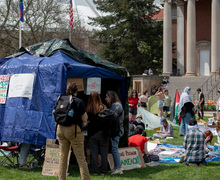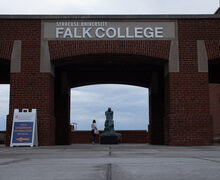Food Recovery Network struggles to save, deliver dinners to local community
Courtesy of Maya Castro
The Food Recovery Network currently collects 500 pounds of food per day and around 2,500 pounds of food per week to deliver to local community organizations like The Determination Center of CNY and The Greater Southside Neighborhood Association.
Get the latest Syracuse news delivered right to your inbox.
Subscribe to our newsletter here.
Over the course of the Spring 2022 semester, Syracuse University and SUNY ESF’s Food Recovery Network collected just over 944 pounds of food from Brockway Dining Hall. But this semester, the dining hall has been running out of food before volunteers from the network arrive.
“(Brockway) says ‘yeah, we can do food recovery,’ and then at the last second they say no,” said FRN President Elliot Salas during one of the organization’s meetings. “I just wish they were more consistent.”
The network is operated by SU and ESF student volunteers who visit the university’s five dining halls to collect unused food after they close. While shelters typically receive non-perishables, FRN Vice President Claire Chevalier said the organization donates “all kinds of food,” like meat, cooked vegetables, rice and potatoes.
In 2021, the organization collected nearly 11 tons of food, providing over 18,300 meals, according to an SU News release.
But FRN has struggled to work with some dining halls this semester, specifically Brockway and Ernie Davis Dining Hall, Salas said. He added that Ernie Davis’ management team wants to reduce the number of times the organization comes to collect leftover food from five times a week — as in previous years — to two.
Ernie Davis’s decision to reduce its collection days could mean 300 fewer pounds of food being delivered to community members each week, Salas said. The FRN donates to nine community centers across the city including the Apostolic Church of Syracuse, The DePalmer House, The Determination Center and The Greater Southside Neighborhood Association.
On average, he said, the organization currently collects 500 pounds of food a day for a total of 2,500 pounds per week.
Ernie Davis’ decision has to do with the dining hall’s own operation, said Sarah Scalese, SU’s senior associate vice president for communications, in a statement to The Daily Orange.
“The decision to move to a two-day pick-up was based on the availability of overproduced food,” Scalese said. “We are constantly seeking to reduce food waste, which inevitably results in the unintentional consequence of reduced contributions to (the Food Recovery Network) and their charitable beneficiaries.”

Courtesy of Maya Castro
The FRN’s staff delivers the food it collects to the community centers the same night it’s recovered, using personal cars to drive and deliver food five days a week throughout the fall and spring semesters. This semester, though, Salas said the organization has struggled to find students who can drive to deliver the food. Only 25% of SU students have cars on campus, according to U.S. News and World Report.
“Hands are easy to get, but not wheels,” Salas said.
Bettie Graham, the Executive Director of the Determination Center of CNY — one of the organizations FRN works with — said the center has been feeling the impacts of FRN’s stifled operations. Over the course of the seven to eight years she’s worked with FRN, Graham said, the Determination Center has relied heavily on its services.

Nicole Beaudet | Design Editor
She said this year is the first time the organization hasn’t been able to provide meals for the center, and that she hasn’t received any communication on why the center hasn’t been getting deliveries or when to expect them in the future.
“I’ve been with them for a very long time, but this year really has not been good at all,” Graham said. “I have like 65 to 75 kids, and (FRN) is something that we really rely on from year to year. It’s been a great, great help in order to feed the kids.”
Still, Graham said FRN’s services have been essential to her work and to the kids who The Determination Center supports, as well as that she hopes for better communication in the future.
“I really do appreciate the program because it really has helped (the center) out, and I appreciate that, I do,” Graham said. “From the bottom of my heart, I do appreciate it. But this year hasn’t been like it has.”
Through the end of the fall semester, Salas said the organization has been working to reconcile the issue and continue deliveries. As a member of SU’s Student Association, Salas said he’s tapped the group for volunteers. Since then, he said the organization has had an easier time getting drivers.
The organization does play a role within Syracuse’s community, said Jackie LaSonde, the founder of the Greater Southside Neighborhood Association. She said the network’s 90 hot dinners are the first thing that Southside residents take when the FRN drops them off at the association each night.
“It really helps out people in the community who may not have access to a meal,” she said.
In 2019, Onondaga County had over 65,000 people on SNAP benefits, a government program providing assistance in buying food. According to 2021 Census data, around 14% of the county uses the program.
While the FRN is currently having difficulties with Ernie Davis Dining Hall, Scalese wrote to The D.O. that changes may be coming.
“Thanks to the active participation of student volunteers, Food Services is actively reviewing (food waste), with the intent of maximizing (the FRN’s) meaningful, impactful and sustainable contributions to the community,” Scalese wrote.
Despite its roadblocks, Salas said he has enjoyed his work with the organization.
“I am so happy for the existence of this club,” Salas said. “It feels incredible that at the end of the day, we are providing food to those in need.”
Published on December 12, 2022 at 10:55 pm





